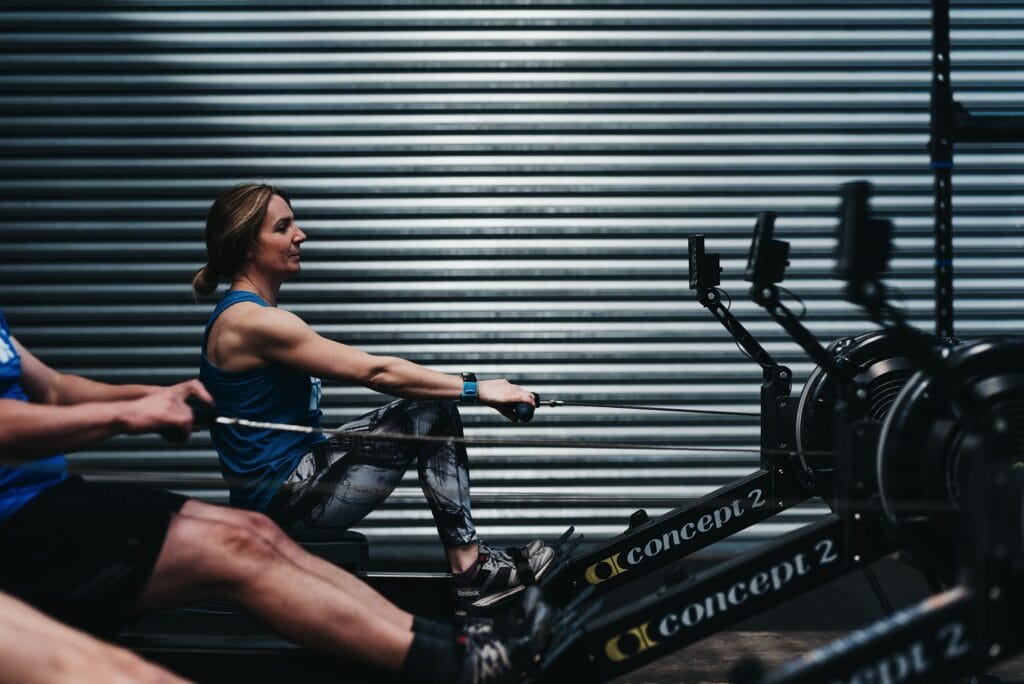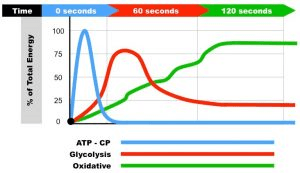Have you ever wondered why our classes are structured the way they are? Do you want to learn how to optimise your training and nutrition to improve your performance?
If you’ve answered ‘YES’ to any of the questions above, then keep reading to find out everything you need to know about our body’s major energy systems and the role they play in your performance and overall fitness level.
So, How Does The Body Produce Energy?
Energy is needed by every cell in the body to function, whether that be muscle contractions for movement and exercise, regulation of body temperature, sleep, breath or any other bodily function.
All energy is produced from the breakdown of the molecule ATP (adenosine triphosphate). ATP is found in all cells of the body – but due to it being a large molecule there is a limited number of ATP in cells. So, when it comes to physical movement and exercise, the ATP gets used up very quickly and needs to be replenished to continue with the exercise.
We have three major energy systems that can restore the ATP: ATP-PC System (AKA Alatic System), Glycolytic System (AKA Lactate System) and Oxidative System (aka Aerobic System). The ATP-PC and the Glycolytic System are anaerobic, meaning that they don’t require oxygen to produce ATP. On the other hand, the Oxidative System is aerobic, because it uses oxygen to produce ATP.
So far, so good?
Here’s exactly how each of these energy systems work to provide energy to our bodies…
The ATP-PC System
The ATP-PC System lasts for 6-10 seconds and is used during maximal power output exercises such as all-out effort sprints, jumps, 1RMs etc. It’s the simplest energy production process, as it enables a fast muscle contraction. There is also no acidic by-product, which usually causes fatigue.
However, this energy system is only in abundance for first 6-10 seconds before it starts to move into deceleration zone, where you start to notice your performance going down. The ATP-PC System rebounds to over 85% in about 3 minutes and is completely replenished after 10 minutes. That’s why it’s important to take rest periods of at least 3 minutes in between these maximal output exercises.
The Glycolytic System
The Glycolytic System relies massively on the rapid breakdown of carbs in the form of glucose that is constantly circulating in the blood stream, and as well as this, glucose is stored in the muscles and liver in the form of glycogen.
When exercising at maximal effort for periods of 10-90 seconds – the glucose and glycogen rapidly go through a process known as ‘glycolysis’ to produce ATP. This is why it’s important to have carbs pre and post training.
Are you a carbophobe? Find out why you shouldn’t be afraid of carbs and why they are important here
During this process lactate and hydrogen ions are produced. Fun fact – it is in the presence of the hydrogen ions in the blood and muscles that make it more acidic and leads to fatigue and the buuuuuurning sensation you love. Poor old lactate gets an unnecessarily bad rep for being the cause!
The Oxidative System
The 3rd Energy System, the Oxidative System involves the use of oxygen to produce ATP – during this system two processes are used. The Krebs Cycle (those that studied Biology at A Level I’m sure will have flash backs of this) and the Electron Transport Chain. So, these two processes can’t produce ATP as quickly as the first two energy systems, but it can produce ATP continually for a far longer period of time! This system can use Carbs, Fats and Protein to fuel the energy system. Fats and Proteins however take far longer to break down in order to produce ATP.
Energy Systems and Nutrition
So, now that you know how these three energy systems work, you can see why nutrition plays an important role in this process. If you want to be a better athlete and an all-round fit individual, you have to include all three major macronutrients in your diet – protein, carbs and fats.
If you are on a low carb diet, you are restricting your body’s ability to fully utilise the Glycolytic and Oxidative systems. It’s also important to understand that, sometimes, your body utilises all 3 energy systems simultaneously. So, during that time, your body will draw energy from all three macronutrients. But, more often than not, there will be a predominant energy system working.
Application to Training
OK, so now that you got this far into this article, it’s time to discuss the exciting stuff – your training.
In order to become more productive and improve the efficiency of producing ATP, we need to train all three energy systems instead of just picking one. Here, at ION we understand the importance of this and we programme our classes accordingly. Here are some examples of how this works:
ATP-PC System
In a lot of our CrossFit classes we include a lifting element, that at times requires an all-out max. effort (relative to your level of ability) for a short period of time, this puts significant stress on our ATP-PC System as it’s the main energy supplier for these near maximal efforts lasting 0-10 secs that require access to high levels of energy as quickly as possible. An example of a workout of this type might be the following:
Every Minute, On the Minute for 10 Minutes
2 Power Cleans @ 70% 1RM
The Glycolytic System and The Oxidative System
A large number of our ION Classes such as ION Conditioning (30 min), ION Assault (45 min) or even our CrossFit (60 min) are performed at High Intensity. It is worth mentioning that intensity is relative to you as an individual. For example, one person’s high intensity might be a fast sprint, whilst for someone else it may be a slow jog.
Workouts can vary from being interval based or more continual. With our Interval sessions, they may consist of workouts such as 90 secs of Hard Work followed by 90 secs of rest and repeating that 5 times. For Example:
5 Rounds
90 sec Window
150m Row
10 Kettlebell Swings
Max. Rep Burpees
90 sec Rest
This sees us placing big demands on both our glycolytic and oxidative system. Energy is needed for the 90 seconds quickly and so our glycolytic system provides this, during the rest periods we need our oxidative system to work quickly in order to replenish the used up ATP. This, in turn, allows you to work harder during the working intervals. A lot of endurance athletes use H.I.I.T style training to improve their performance, rather than sticking solely to continual long duration efforts.
Other workouts may consist of 15-20 min continual work that will then be predominantly stressing the oxidative system. For example:
In 20 mins perform as many rounds as possible of
10 Deadlifts
12 Box Jumps/or Step Ups
15 Diamond Sit Ups
200m Run
So, believe it or not, there is certainly a method behind the madness within our daily classes. Our goal as coaches is to help you improve your all-round fitness and boost all 3 energy systems.
If you have any questions on how to improve your overall fitness level and achieve your goals, get in touch with our coaches! Whether you’re struggling with nutrition, exercise or want to prepare for a specific event, we are here to help you achieve your goals and live a happy, active life.
Robin Sowden-Taylor




